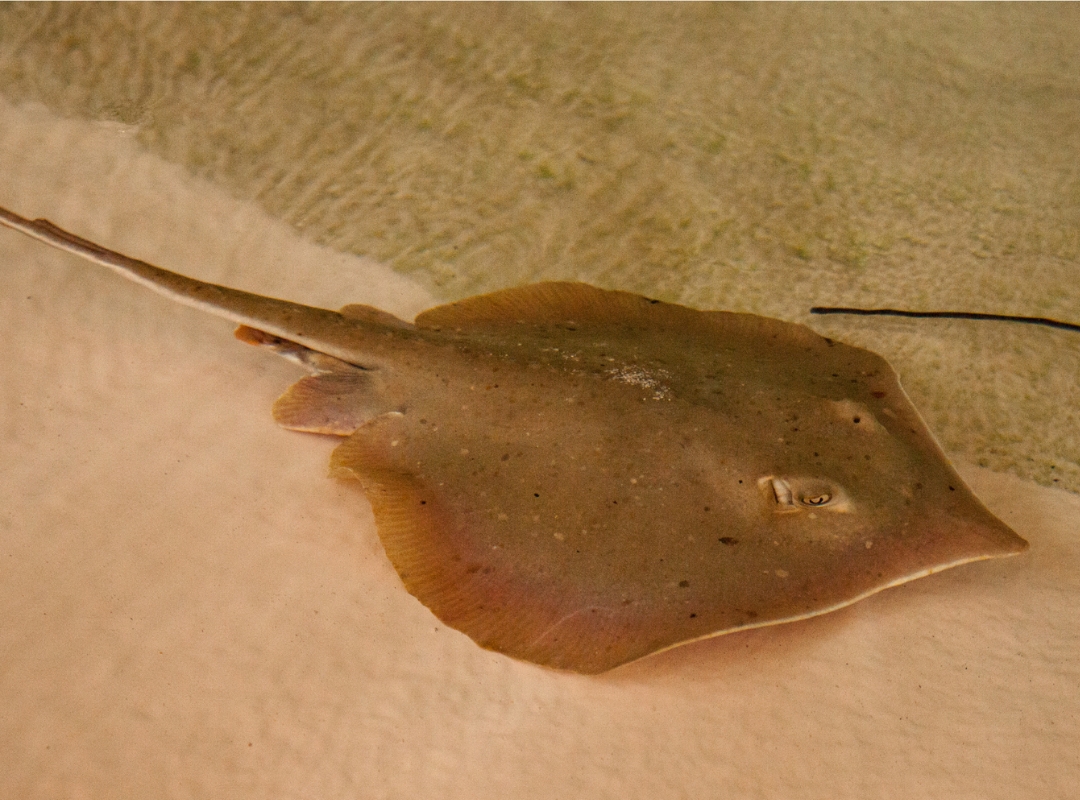Species Name
Jenkins Whipray
Scientific Name
Pateobatis jenkinsii
Family Name
Dasyatidae
IUCN Status
Vulnerable
Stingray with a kite-shaped disc that is wider than long; snout fairly short and obtusely angular; a thin but prominent, dense denticle band on mid-shoulder; row of pronounced wedge-shaped thorns along midline; pectoral fin with rounded outer margin, pelvic fin small and narrow; dorsal surface uniformly yellowish brown (rarely with small dark spots on disc near tail base), black beyond the tail sting.
Biology
Length: This species grows to a maximum size of about 300 cm in total length and at least 150 cm in disc width (DW). Males are about 75-85 cm DW as they develop, and they are about 23 cm DW at birth.
Gestation period: Unknown
Littter size: Reproduction is viviparous with histotrophy, unknown litter size.
Life Expectancy: Unknown
Diet: Primarily feed on small fish, crustaceans, and other aquatic invertebrates
Habitat and Distribution
Habitat: Found inshore, on sandy substrates to depths of 50m. Inhabits shallow coastal waters.
Distribution: Jenkins' Whipray is found in the Indo-West Pacific, from southern Africa to Australia, New Guinea, and the Philippines.
Depth: Usually found at less than 50 m depth, but also reportedly to 90 m.
Known landing centres: Thoothukudi, Junglighat, Burmanallah, Wandoor, Dignabad and Malvan
Commerical Value
Bycatch caught in trawl nets is sold in the local market for human consumption.
Threats
Inshore fishing pressure by being caught in commercial fisheries (especially trawlers) are landed and sold as food fish. This species is caught by demersal tangle net, bottom trawls, commercial gillnet and longline fisheries.
References
- Kizhakudan et al. 2018 Field identification of batoids – a guide to Indian species. CMFRI Special Publication (132). ICAR - Central Marine Fisheries Research Institute, Kochi.


Related Species
- Cowtail Ray
- Coach Whipray
- Scaly Whipray
- Whitespotted Whipray
- Arabian Banded Whipray
- Bengal Whipray
- Bennett's Stingray
- Blackedge Whipray
- Bleeker’s Whipray
- Blotched Fantail Ray
- Bluespotted Lagoon Ray
- Bluespotted Maskray
- Broad Cowtail Ray
- Brown Stingray
- Giant Freshwater Whipray
- Honeycomb Whipray
- Indian Sharpnose Ray
- Kuhl's Maskray
- Leopard Whipray
- Mangrove Whipray
- Narrow Cowtail Ray
- Pakistan Whipray
- Pale-edge Sharpnose Ray
- Pelagic Stingray
- Pink Whipray
- Porcupine Ray
- Roughtail Stingray
- Round Whipray
- Shorttail Whipray
- Smalleye Stingray

